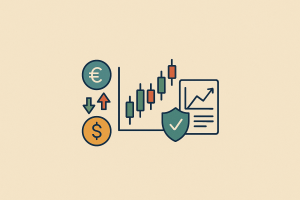Introduction
In April 2025, forex traders across the globe are paying close attention to the movements in the USD/JPY currency pair, especially after renowned analyst Omkar Godbole released a comprehensive breakdown of its current dynamics. The USD/JPY pair, a key barometer of global risk sentiment, has historically been one of the most actively traded currency pairs due to its liquidity and sensitivity to interest rate differentials between the United States and Japan. With macroeconomic forces shifting rapidly in the first quarter of 2025, Godbole’s analysis provides crucial insights into how the dollar and yen are poised to perform in the near term.
The currency market is being shaped by several significant factors including diverging monetary policies between the Federal Reserve and the Bank of Japan, inflation trends in both economies, geopolitical pressures, and technical signals emerging on key charts. Traders are not only looking for direction but also context — and this is precisely what Godbole delivers through his analysis.
Overview Of Recent USD/JPY Price Movements
Godbole’s report highlights the oscillation of USD/JPY between 148.20 and 152.50 over recent weeks. The pair has demonstrated high sensitivity to comments made by Fed officials and indicators showing the resilience of the US economy. In contrast, the Japanese yen continues to face structural weaknesses stemming from Japan’s persistently low inflation and accommodative monetary policy stance.
Since the beginning of 2025, the dollar has generally been buoyed by stronger-than-expected economic data including better-than-forecast job growth, moderate inflation prints, and positive retail sales figures. These factors have prompted speculation that the Federal Reserve may maintain higher interest rates for longer than previously anticipated.
Meanwhile, the yen has continued to weaken amid the Bank of Japan’s cautious approach to policy normalization. Although the BOJ ended its yield curve control policy in late 2024 and marginally increased interest rates, the central bank remains considerably dovish compared to its Western counterparts. The gap between the US and Japanese yields continues to widen, putting downward pressure on the yen.
Central Bank Divergence And Its Influence On USD/JPY
One of the central themes of Godbole’s analysis is the ongoing policy divergence between the US Federal Reserve and the Bank of Japan. In his view, this divergence remains the primary driver behind USD/JPY price action. The Fed has continued to emphasize a data-dependent approach but remains concerned about upside risks to inflation. As a result, market expectations for rate cuts have been pushed further out into late 2025 or even early 2026.
Conversely, the Bank of Japan has shown limited urgency in tightening monetary policy. Although inflation in Japan is slowly rising, it remains well below the BOJ’s target on a sustained basis. Moreover, wage growth in Japan has not been strong enough to warrant aggressive tightening. The BOJ has adopted a wait-and-see stance, suggesting that its tightening path will be shallow and slow.
This disparity in central bank outlooks reinforces upward pressure on USD/JPY. As long as interest rate differentials remain wide, the carry trade — borrowing in yen and investing in higher-yielding assets — is likely to remain attractive to global investors, further weakening the yen.
Inflation, Employment And Economic Sentiment: US Vs. Japan
Another key aspect Godbole discusses is the macroeconomic divergence between the United States and Japan. US inflation, while cooling, remains above the Fed’s 2 percent target. The labor market has also remained strong with unemployment hovering below 4 percent, and wage growth staying steady. These data points support the Fed’s cautious approach to cutting rates too soon.
In Japan, inflation is gradually climbing but still lacks the momentum needed to shift policy drastically. Core CPI has edged higher, but much of it is attributed to global supply-side pressures and currency depreciation rather than domestic demand. Moreover, consumer spending remains tepid in Japan, and business investment is constrained by labor shortages and demographic challenges.
Godbole’s analysis suggests that unless Japan experiences a sustained rise in wages and consumer demand, the BOJ will likely avoid aggressive tightening. This limits upside potential for the yen, especially in a global environment where other central banks are still maintaining relatively high interest rates.
Technical Analysis: Key Levels To Watch
From a technical perspective, Godbole emphasizes several key support and resistance zones. The primary resistance sits at 152.50, a level that the pair has tested multiple times in early 2025. A decisive breakout above this level could open the door for a move toward 155.00 in the coming months, especially if the Fed remains hawkish.
On the downside, the 148.00 level is seen as critical support. A break below this zone would likely coincide with a dovish shift by the Fed or an unexpectedly hawkish move by the BOJ. Other key technical indicators such as the Relative Strength Index (RSI) and Moving Average Convergence Divergence (MACD) are signaling consolidation, which may precede a breakout in either direction.
Godbole also notes the importance of long-term moving averages. The 200-day moving average, in particular, has been acting as a dynamic support zone. Traders watching this level may use it as a trigger point for long positions if the pair rebounds from it during dips.
Market Sentiment And Global Risk Appetite
Beyond fundamentals and technicals, market sentiment continues to play a pivotal role in driving the USD/JPY pair. Godbole’s commentary touches on how risk-on or risk-off sentiment affects the yen, which is often viewed as a safe-haven currency. In times of global uncertainty — such as geopolitical tensions, banking instability, or commodity shocks — the yen tends to appreciate as investors seek refuge.
However, in the current macro environment, market sentiment has been relatively stable. US equities are trending higher, and volatility indices remain subdued. This kind of environment typically favors the dollar, as investors chase higher yields and avoid low-return currencies like the yen.
Godbole suggests that any abrupt change in risk sentiment could temporarily bolster the yen. However, such rallies are likely to be short-lived unless they are accompanied by structural changes in BOJ policy or a significant economic slowdown in the US.
What This Means For Traders?
For forex traders, the USD/JPY pair presents both opportunity and risk. Godbole’s analysis encourages traders to watch for confirmation signals from both macroeconomic data and chart patterns. For example, a hotter-than-expected US inflation print could trigger a renewed push higher, especially if accompanied by hawkish Fed commentary.
Traders should also keep an eye on speeches from BOJ officials, particularly if there are hints at a policy shift. Intervention threats from Japanese policymakers may also enter the conversation if the yen weakens past critical psychological levels like 155.00.
Risk management remains key. With central banks taking a data-driven approach and markets reacting swiftly to any surprises, volatility is always a factor. Stop-loss orders, proper position sizing, and diversification are essential to navigating this environment.
Conclusion
As we head into the second quarter of 2025, Omkar Godbole’s insights provide a strong foundation for understanding USD/JPY price action. The pair remains fundamentally supported by central bank divergence and interest rate differentials. While technicals show signs of consolidation, a breakout seems likely — potentially triggered by inflation surprises or changes in monetary policy guidance.
For investors and traders alike, staying informed and adaptive will be the key to capitalizing on opportunities while managing risk. The USD/JPY pair remains one of the most telling indicators of global sentiment and policy divergence, making it a vital focus for anyone active in the forex markets.



